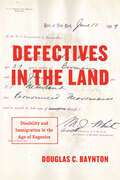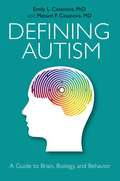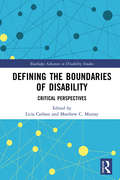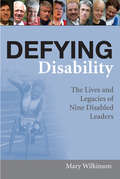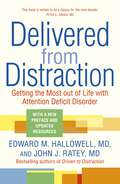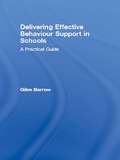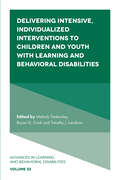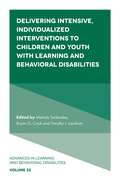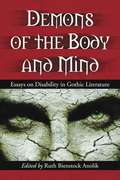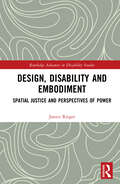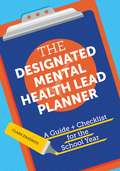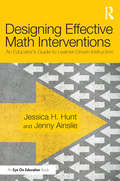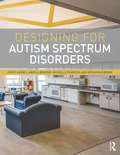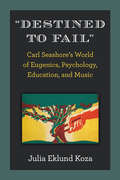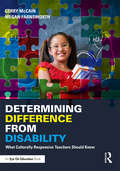- Table View
- List View
Defectives in the Land: Disability and Immigration in the Age of Eugenics
by Douglas C. BayntonImmigration history has largely focused on the restriction of immigrants by race and ethnicity, overlooking disability as a crucial factor in the crafting of the image of the “undesirable immigrant.” Defectives in the Land, Douglas C. Baynton’s groundbreaking new look at immigration and disability, aims to change this. In the late nineteenth and early twentieth centuries, Baynton explains, immigration restriction in the United States was primarily intended to keep people with disabilities—known as “defectives”—out of the country. The list of those included is long: the deaf, blind, epileptic, and mobility impaired; people with curved spines, hernias, flat or club feet, missing limbs, and short limbs; those unusually short or tall; people with intellectual or psychiatric disabilities; intersexuals; men of “poor physique” and men diagnosed with “feminism.” Not only were disabled individuals excluded, but particular races and nationalities were also identified as undesirable based on their supposed susceptibility to mental, moral, and physical defects. In this transformative book, Baynton argues that early immigration laws were a cohesive whole—a decades-long effort to find an effective method of excluding people considered to be defective. This effort was one aspect of a national culture that was increasingly fixated on competition and efficiency, anxious about physical appearance and difference, and haunted by a fear of hereditary defect and the degeneration of the American race.
Defectives in the Land: Disability and Immigration in the Age of Eugenics
by Douglas C. BayntonImmigration history has largely focused on the restriction of immigrants by race and ethnicity, overlooking disability as a crucial factor in the crafting of the image of the “undesirable immigrant.” Defectives in the Land, Douglas C. Baynton’s groundbreaking new look at immigration and disability, aims to change this. In the late nineteenth and early twentieth centuries, Baynton explains, immigration restriction in the United States was primarily intended to keep people with disabilities—known as “defectives”—out of the country. The list of those included is long: the deaf, blind, epileptic, and mobility impaired; people with curved spines, hernias, flat or club feet, missing limbs, and short limbs; those unusually short or tall; people with intellectual or psychiatric disabilities; intersexuals; men of “poor physique” and men diagnosed with “feminism.” Not only were disabled individuals excluded, but particular races and nationalities were also identified as undesirable based on their supposed susceptibility to mental, moral, and physical defects. In this transformative book, Baynton argues that early immigration laws were a cohesive whole—a decades-long effort to find an effective method of excluding people considered to be defective. This effort was one aspect of a national culture that was increasingly fixated on competition and efficiency, anxious about physical appearance and difference, and haunted by a fear of hereditary defect and the degeneration of the American race.
Defining Autism: A Guide to Brain, Biology, and Behavior
by Emily L. Casanova Manuel CasanovaOffering a summary of the current state of knowledge in autism research, Defining Autism looks at the different genetic, neurological and environmental causes of, and contributory factors to autism. It takes a wide-ranging view of developmental and genetic factors, and considers autism's relationship with other conditions such as epilepsy. Shedding light on the vast number of autism-related syndromes which are all too often denied adequate attention, it shows how, whilst autism refers to a single syndrome, it can be understood as many different conditions, with the common factors being biological, rather than behavioral.
Defining Autism: A Guide to Brain, Biology, and Behavior
by Emily L. Casanova Manuel CasanovaOffering a summary of the current state of knowledge in autism research, Defining Autism looks at the different genetic, neurological and environmental causes of, and contributory factors to autism. It takes a wide-ranging view of developmental and genetic factors, and considers autism's relationship with other conditions such as epilepsy. Shedding light on the vast number of autism-related syndromes which are all too often denied adequate attention, it shows how, whilst autism refers to a single syndrome, it can be understood as many different conditions, with the common factors being biological, rather than behavioral.
Defining the Boundaries of Disability: Critical Perspectives (Routledge Advances in Disability Studies)
by Licia CarlsonThis ground-breaking volume considers what it means to make claims of disability membership in view of the robust Disability Rights movement, the rich areas of academic inquiry into disability, increased philosophical attention to the nature and significance of disability, a vibrant disability culture and disability arts movement, and advances in biomedical science and technology. By focusing on the statement, "We are all disabled", the book explores the following questions: What are the philosophical, political, and practical implications of making this claim? What conceptions of disability underlie it? When, if ever, is this claim justified, and when or why might it be problematic or harmful? What are the implications of claiming "we are all disabled" amidst this global COVID-19 pandemic? These critical reflections on the boundaries of disability include perspectives from the humanities, social sciences, law, and the arts. In exploring the boundaries of disability, and the ways in which these lines are drawn theoretically, legally, medically, socially, and culturally, the authors in this volume challenge particular conceptions of disability, expand the meaning and significance of the term, and consider the implications of claiming disability as an identity. It will be of interest to a broad audience, including disability scholars, advocates and activists, philosophers and historians of disability, moral theorists, clinicians, legal scholars, and artists.
Defining the Boundaries of Disability: Critical Perspectives (Routledge Advances in Disability Studies)
by Licia Carlson Matthew C. MurrayThis ground-breaking volume considers what it means to make claims of disability membership in view of the robust Disability Rights movement, the rich areas of academic inquiry into disability, increased philosophical attention to the nature and significance of disability, a vibrant disability culture and disability arts movement, and advances in biomedical science and technology. By focusing on the statement, "We are all disabled", the book explores the following questions: What are the philosophical, political, and practical implications of making this claim? What conceptions of disability underlie it? When, if ever, is this claim justified, and when or why might it be problematic or harmful? What are the implications of claiming "we are all disabled" amidst this global COVID-19 pandemic? These critical reflections on the boundaries of disability include perspectives from the humanities, social sciences, law, and the arts. In exploring the boundaries of disability, and the ways in which these lines are drawn theoretically, legally, medically, socially, and culturally, the authors in this volume challenge particular conceptions of disability, expand the meaning and significance of the term, and consider the implications of claiming disability as an identity. It will be of interest to a broad audience, including disability scholars, advocates and activists, philosophers and historians of disability, moral theorists, clinicians, legal scholars, and artists.
Defying Disability: The Lives and Legacies of Nine Disabled Leaders
by Mary WilkinsonThis book tells the stories of nine disabled leaders who, by force of personality and concrete achievement, have made us think differently about disability. Whatever direction they have come from, they share a common will to change society so that disabled people get a fair deal. There are compelling biographies of: · Sir Bert Massie: public servant · Lord (Jack) Ashley: Labour politician · Rachel Hurst: activist and campaigner · Tom Shakespeare: academic · Phil Friend: entrepreneur and business consultant · Peter White: broadcaster · Mat Fraser: actor, musician and performer · Andrew Lee: activist and campaigner · Dame Tanni Grey-Thompson: Paralympic champion Defying Disability is based on extensive interviews with the subjects and the people who know them. It marks their similarities and differences, the forces that drove them to achieve, the impact they have had on policies and practice, and how the modern history of disability in the UK has been played out in their lives. Defying Disability is not just a good read; it will inform professionals in the field, students in disability studies, disabled people, their families and carers, and everyone interested in disability politics and policies.
Defying Disability: The Lives and Legacies of Nine Disabled Leaders (PDF)
by Mary WilkinsonThis book tells the stories of nine disabled leaders who, by force of personality and concrete achievement, have made us think differently about disability. Whatever direction they have come from, they share a common will to change society so that disabled people get a fair deal. There are compelling biographies of: · Sir Bert Massie: public servant · Lord (Jack) Ashley: Labour politician · Rachel Hurst: activist and campaigner · Tom Shakespeare: academic · Phil Friend: entrepreneur and business consultant · Peter White: broadcaster · Mat Fraser: actor, musician and performer · Andrew Lee: activist and campaigner · Dame Tanni Grey-Thompson: Paralympic champion Defying Disability is based on extensive interviews with the subjects and the people who know them. It marks their similarities and differences, the forces that drove them to achieve, the impact they have had on policies and practice, and how the modern history of disability in the UK has been played out in their lives. Defying Disability is not just a good read; it will inform professionals in the field, students in disability studies, disabled people, their families and carers, and everyone interested in disability politics and policies.
Dekolonialisierung des Wissens: Eine partizipative Studie zu Diskriminierung und Teilhabe an Erwerbsarbeit von BIPoC mit Behinderungserfahrungen (Gesellschaft der Unterschiede #85)
by Robel Afeworki AbayDie voranschreitende Geopolitik geht mit komplexen Formen epistemischer Gewalt eurozentristischer Wissensordnungen einher. Diese zeigt sich auch in der Weitertradierung komplexitätsreduzierender Wissensproduktion sowohl über Behinderung als auch über Migration/Flucht: Es wird wiederholt über die Betroffenen, statt mit ihnen gesprochen. Robel Afeworki Abay widmet sich der Diskriminierung und Teilhabe an Erwerbsarbeit von BIPoC mit Behinderungserfahrungen und beleuchtet aus postkolonialen und intersektionalen Perspektiven die Zugangsbarrieren und Bewältigungsressourcen der Betroffenen. In seiner partizipativen Studie legt er dar, dass epistemische Gewalt hierbei als konstitutiver Bestandteil der Kolonialität des Wissens fungiert.
Dekolonialisierung des Wissens: Eine partizipative Studie zu Diskriminierung und Teilhabe an Erwerbsarbeit von BIPoC mit Behinderungserfahrungen (Gesellschaft der Unterschiede #85)
by Robel Afeworki AbayDie voranschreitende Geopolitik geht mit komplexen Formen epistemischer Gewalt eurozentristischer Wissensordnungen einher. Diese zeigt sich auch in der Weitertradierung komplexitätsreduzierender Wissensproduktion sowohl über Behinderung als auch über Migration/Flucht: Es wird wiederholt über die Betroffenen, statt mit ihnen gesprochen. Robel Afeworki Abay widmet sich der Diskriminierung und Teilhabe an Erwerbsarbeit von BIPoC mit Behinderungserfahrungen und beleuchtet aus postkolonialen und intersektionalen Perspektiven die Zugangsbarrieren und Bewältigungsressourcen der Betroffenen. In seiner partizipativen Studie legt er dar, dass epistemische Gewalt hierbei als konstitutiver Bestandteil der Kolonialität des Wissens fungiert.
Delivered from Distraction: Getting the Most out of Life with Attention Deficit Disorder
by Edward M. Hallowell John J. Ratey'If you read only one book about attention deficit disorder, it should be Delivered from Distraction.' Michael Thompson, Ph.D., New York Times bestselling co-author of Raising CainIn 1994, Driven to Distraction sparked a revolution in our understanding of attention deficit disorder. Widely recognized as the classic in the field, the book has sold more than a million copies. Now a second revolution is under way in the approach to ADD, and the news is great. Drug therapies, our understanding of the role of diet and exercise, even the way we define the disorder - all are changing radically. And doctors are realizing that millions of adults suffer from this condition, though the vast majority of them remain undiagnosed and untreated. In this new book, Drs Edward M. Hallowell and John J. Ratey build on the breakthroughs of Driven to Distraction to offer a comprehensive and entirely up-to-date guide to living a successful life with ADD.As Hallowell and Ratey point out, 'attention deficit disorder' is a highly misleading description of an intriguing kind of mind. Original, charismatic, energetic, often brilliant, people with ADD have extraordinary talents and gifts embedded in their highly charged but easily distracted minds. Tailored expressly to ADD learning styles and attention spans, Delivered from Distraction provides accessible, engaging discussions of every aspect of the condition, from diagnosis to finding the proper treatment regime. Inside you'll discover:- whether ADD runs in families- new diagnostic procedures, tests, and evaluations- the links between ADD and other conditions- how people with ADD can free up their inner talents and strengths- the new drugs and how they work, and why they're not for everyone- exciting advances in nonpharmaceutical therapies, including changes in diet, exercise, and lifestyle- how to adapt the classic twelve-step program to treat ADD- sexual problems associated with ADD and how to resolve them- strategies for dealing with procrastination, clutter, and chronic forgetfulnessADD is a trait, a way of living in the world. It only becomes a disorder when it impairs your life. Featuring gripping profiles of patients with ADD who have triumphed, Delivered from Distraction is a wise, loving guide to releasing the positive energy that all people with ADD hold inside. If you have ADD or care about someone who does, this is the book you must read.
Delivering Effective Behaviour Support in Schools: A Practical Guide
by Giles BarrowThis book is intended to help schools become increasingly inclusive. The advice and guidance is aimed at managers and practitioners providing behavior support, either through an LEA service, by outreach work from specialist centers or via on-site provision. You will find advice on developing effective support; planning, monitoring and evaluating support; working in partnership with colleagues in schools and other services; identifying resources to maximize behavior support interventions; and providing support staff with proven techniques for improving service delivery. There are lots of practical resources for implementing suggested strategies, examples of proformas and spreadsheet formats and other useful planning materials relating to behavior support. Managers of behavior support services should find this book particularly helpful, as will those staff providing behavior support from PRUs (Pupil Referral Units), on-site units and special schools. There will also be aspects of the book that will appeal to mentors and staff with pastoral responsibilities in mainstream schools.
Delivering Effective Behaviour Support in Schools: A Practical Guide
by Giles BarrowThis book is intended to help schools become increasingly inclusive. The advice and guidance is aimed at managers and practitioners providing behavior support, either through an LEA service, by outreach work from specialist centers or via on-site provision. You will find advice on developing effective support; planning, monitoring and evaluating support; working in partnership with colleagues in schools and other services; identifying resources to maximize behavior support interventions; and providing support staff with proven techniques for improving service delivery. There are lots of practical resources for implementing suggested strategies, examples of proformas and spreadsheet formats and other useful planning materials relating to behavior support. Managers of behavior support services should find this book particularly helpful, as will those staff providing behavior support from PRUs (Pupil Referral Units), on-site units and special schools. There will also be aspects of the book that will appeal to mentors and staff with pastoral responsibilities in mainstream schools.
Delivering Intensive, Individualized Interventions to Children and Youth with Learning and Behavioral Disabilities (Advances in Learning and Behavioral Disabilities #32)
by Melody Tankersley, Bryan G. Cook, Timothy J. LandrumIntensive, individualized interventions are certainly the hallmark promise of special education. In a multi-tiered system of supports (MTSS), tier 3 interventions are the most intensive and require individualized delivery to address the learning and behavioral needs of students who are most often identified for special education services. MTSS, such as Responsiveness to Intervention (RTI) and Positive Behavioral Interventions and Supports (PBIS), are comprised of universal assessment, progress monitoring, and databased decision-making as intervention is implemented with increasing intensity and individualization based on the needs of the learner. The chapters in this volume cover a broad range of topics that address issues surrounding the identification of students who need the most intensive intervention, intensive intervention features and delivery considerations, behavioral interventions, academic interventions, and preservice teacher preparation. The authors of the chapters are recognized as international experts on these topics and provide specific recommendations that are based on research evidence as well as discuss considerations for future enhancement of multi-tiered systems of supports and intensive interventions. This is a contemporary resource for teachers, administrators, and teacher-educators who are charged with delivering special education and/or supporting those who do.
Delivering Intensive, Individualized Interventions to Children and Youth with Learning and Behavioral Disabilities (Advances in Learning and Behavioral Disabilities #32)
by Melody Tankersley Bryan G. Cook Timothy J. LandrumIntensive, individualized interventions are certainly the hallmark promise of special education. In a multi-tiered system of supports (MTSS), tier 3 interventions are the most intensive and require individualized delivery to address the learning and behavioral needs of students who are most often identified for special education services. MTSS, such as Responsiveness to Intervention (RTI) and Positive Behavioral Interventions and Supports (PBIS), are comprised of universal assessment, progress monitoring, and databased decision-making as intervention is implemented with increasing intensity and individualization based on the needs of the learner. The chapters in this volume cover a broad range of topics that address issues surrounding the identification of students who need the most intensive intervention, intensive intervention features and delivery considerations, behavioral interventions, academic interventions, and preservice teacher preparation. The authors of the chapters are recognized as international experts on these topics and provide specific recommendations that are based on research evidence as well as discuss considerations for future enhancement of multi-tiered systems of supports and intensive interventions. This is a contemporary resource for teachers, administrators, and teacher-educators who are charged with delivering special education and/or supporting those who do.
Demons Of The Body And Mind: Essays On Disability In Gothic Literature
by Ruth Bienstock AnolikThe Gothic mode, typically preoccupied by questions of difference and otherness, consistently imagines the Other as a source of grotesque horror. The sixteen critical essays in this collection examine the ways in which those suffering from mental and physical ailments are refigured as Other, and how they are imagined to be monstrous. Together, the essays highlight the Gothic inclination to represent all ailments as visibly monstrous, even those, such as mental illness, which were invisible. Paradoxically, the Other also becomes a pitiful figure, often evoking empathy. This exploration of illness and disability represents a strong addition to Gothic studies.
Design, Disability and Embodiment: Spatial Justice and Perspectives of Power (Routledge Advances in Disability Studies)
by Janice RiegerThis timely book explores the spatial and social injustices within our streets, malls, schools, and public institutions. Taken-for-granted acts like going for a walk, seeing an exhibition with a friend, and going to school are, for people with disabilities, conditional or precluded acts due to exclusion by design. This book stimulates debate and discussion about current practice and studies in spatial design in the context of disability and the growing need for inclusive design globally. Case studies of inclusive design in spaces like museums, malls, galleries and universities are presented to challenge and expose the perspectives of power and spatial injustices that still exist within these spaces today. The international case studies presented purposely privilege the voices and perspectives of people with disabilities, to expose the multisensorial perspectives of spatial justice in order to understand inclusion more holistically through embodiment. If you are an architect, designer, arts educator, curator or museum professional or just want a world where spatial justice is possible, then this book will provide you with a new perspective of spatial design through critical disability studies, allyship and codesign, where tangible approaches and practices for inclusive design are explored.
Design, Disability and Embodiment: Spatial Justice and Perspectives of Power (Routledge Advances in Disability Studies)
by Janice RiegerThis timely book explores the spatial and social injustices within our streets, malls, schools, and public institutions. Taken-for-granted acts like going for a walk, seeing an exhibition with a friend, and going to school are, for people with disabilities, conditional or precluded acts due to exclusion by design. This book stimulates debate and discussion about current practice and studies in spatial design in the context of disability and the growing need for inclusive design globally. Case studies of inclusive design in spaces like museums, malls, galleries and universities are presented to challenge and expose the perspectives of power and spatial injustices that still exist within these spaces today. The international case studies presented purposely privilege the voices and perspectives of people with disabilities, to expose the multisensorial perspectives of spatial justice in order to understand inclusion more holistically through embodiment. If you are an architect, designer, arts educator, curator or museum professional or just want a world where spatial justice is possible, then this book will provide you with a new perspective of spatial design through critical disability studies, allyship and codesign, where tangible approaches and practices for inclusive design are explored.
The Designated Mental Health Lead Planner: A Guide and Checklist for the School Year
by Clare ErasmusThis planner provides detailed guidance on what a Designated Mental Health Lead needs to do, when they need to do it, and how they can achieve the best results. It gives a clear focus and checklist for each week, including spaces to add your own to-do list, and encourages reflection on the outcomes and impact of your actions on pupils' attainment and wellbeing. It also encourages a focus on your own development and self-care, with space to record what you are currently reading or listening to and one thing you are grateful for that week.In addition to the termly and weekly plans, the book provides short briefs on key aspects of the role, including how to work effectively with teachers, the HR team, the DSL, governors, the pastoral team, Mental Health Support Teams and parents. It is an invaluable resource for all DMHLs tackling the 39 academic weeks.
Designing Effective Math Interventions: An Educator's Guide to Learner-Driven Instruction
by Jessica H. Hunt Jenny AinslieDesign effective, learner-driven math interventions with this accessible and thought-provoking guidebook. Learn how to set up instruction to promote participation and understanding, plan purposeful, targeted tasks, develop student thinking, and create tools to assess student work in a way that measures learning, not just performance. Chapters explore questions that educators frequently struggle with when designing interventions, offering user-friendly research and evidence-based strategies to help overcome common hurdles. This book is essential reading for anyone seeking an adaptive approach to Tier 2 and 3 interventions that positions struggling students as competent learners.
Designing Effective Math Interventions: An Educator's Guide to Learner-Driven Instruction
by Jessica H. Hunt Jenny AinslieDesign effective, learner-driven math interventions with this accessible and thought-provoking guidebook. Learn how to set up instruction to promote participation and understanding, plan purposeful, targeted tasks, develop student thinking, and create tools to assess student work in a way that measures learning, not just performance. Chapters explore questions that educators frequently struggle with when designing interventions, offering user-friendly research and evidence-based strategies to help overcome common hurdles. This book is essential reading for anyone seeking an adaptive approach to Tier 2 and 3 interventions that positions struggling students as competent learners.
Designing for Autism Spectrum Disorders
by Angela Bourne Michelle Pearson Kristi Gaines Mesha KleibrinkWinner of the 2017 IDEC Book Award, 2017 EDRA Great Places Award (Book Category), 2017 American Society of Interior Designers Joel Polsky Prize and the 2016 International Interior Design Association TXOK Research Award Designing for Autism Spectrum Disorders explains the influence of the natural and man-made environment on individuals with autism spectrum disorders (ASD) and other forms of intellectual/developmental disabilities (IDD). Drawing on the latest research in the fields of environmental psychology and education, the authors show you how architecture and interior spaces can positively influence individuals with neurodiversities by modifying factors such as color, lighting, space organization, textures, acoustics, and ventilation. Now you can design homes, therapeutic environments, work environments, and outdoor spaces to encourage growth and learning for the projected 500,000 children with ASD (in the United States alone) who are expected to reach adulthood by 2024. Topics discussed include:-Environmental design theories-Symptoms of ASD-Sensory processing deficits -Design needs of individuals on the spectrum at all ages-Design methods and solutions for spaces, including residential, learning, work, and therapeutic environments encompassing a wide range of budgets-Designing for self-actualization, well-being, and a high quality of life for the duration of an individual's life-Avenues for healthy living and aging in place-Biophilic design-Environmental impact on well-being -Strategies to promote active living as an integral part of the welfare focus.
Designing for Autism Spectrum Disorders
by Angela Bourne Michelle Pearson Kristi Gaines Mesha KleibrinkWinner of the 2017 IDEC Book Award, 2017 EDRA Great Places Award (Book Category), 2017 American Society of Interior Designers Joel Polsky Prize and the 2016 International Interior Design Association TXOK Research Award Designing for Autism Spectrum Disorders explains the influence of the natural and man-made environment on individuals with autism spectrum disorders (ASD) and other forms of intellectual/developmental disabilities (IDD). Drawing on the latest research in the fields of environmental psychology and education, the authors show you how architecture and interior spaces can positively influence individuals with neurodiversities by modifying factors such as color, lighting, space organization, textures, acoustics, and ventilation. Now you can design homes, therapeutic environments, work environments, and outdoor spaces to encourage growth and learning for the projected 500,000 children with ASD (in the United States alone) who are expected to reach adulthood by 2024. Topics discussed include:-Environmental design theories-Symptoms of ASD-Sensory processing deficits -Design needs of individuals on the spectrum at all ages-Design methods and solutions for spaces, including residential, learning, work, and therapeutic environments encompassing a wide range of budgets-Designing for self-actualization, well-being, and a high quality of life for the duration of an individual's life-Avenues for healthy living and aging in place-Biophilic design-Environmental impact on well-being -Strategies to promote active living as an integral part of the welfare focus.
"Destined to Fail": Carl Seashore’s World of Eugenics, Psychology, Education, and Music
by Julia KozaA little-known fact about the prominent US psychologist and educator Carl E. Seashore (1866–1949) is that he was deeply involved in the American eugenics movement. He was among the US academics to support eugenics long before German Nazis embraced it. A titan in a host of disciplines and a proponent of radical education reform, Seashore used his positional power to promote a constellation of education reforms consistent with central precepts of eugenics. Many of these reforms, including tracking, gifted and talented programs, and high-stakes standardized testing, were adopted and remain standard practice in the United States today. He promulgated the idea that musical talent is biologically inheritable, and he developed the first standardized tests of musical talent; these tests were used by early-twentieth-century researchers in their attempts to determine whether there are race differences in musical talent. Seashore’s ideas and work profoundly shaped music education’s research trajectory, as well as enduring “commonsense” beliefs about musical ability. An intersectional analysis, “Destined to Fail” focuses on the relationship between eugenics and Seashore’s views on ability, race, and gender. Koza concludes that Seashore promoted eugenics and its companion, euthenics, because he was a true believer. She also discusses the longstanding silences surrounding Seashore’s participation in eugenics. As a diagnosis and critique of the present, “Destined to Fail” identifies resemblances and connections between past and present that illustrate the continuing influence of eugenics—and the systems of reasoning that made early-twentieth-century eugenics imaginable and seem reasonable—on education discourse and practice today. It maps out discursive, citational, and funding connections between eugenicists of the early twentieth-century and contemporary White supremacists; this mapping leads to some of Donald Trump’s supporters and appointees.
Determining Difference from Disability: What Culturally Responsive Teachers Should Know
by Gerry McCain Megan FarnsworthThis essential book offers clear guidelines for determining if the Culturally Linguistically Diverse (CLD) students / English Language Learners (ELL) in your general education classroom are experiencing typical language differences, learning disabilities, or both. By combining helpful case-studies with insightful research, the authors provide a framework for differentiating instruction that uses culturally appropriate interventions to build upon student strengths while creating a foundation for further learning and achievement. You will discover how to: Connect your own and your students’ cultural assets to classroom content; Review language acquisition stages and design corresponding instruction; Collaborate with peers and discuss the realities of reaching out for support and problem solving; Choose effective and appropriate instructional strategies based on documentation of data through progress monitoring; Move from a traditional behavioristic perspective to a more culturally responsive perspective; Identify patterns in formal assessments and informal instruction in order to distinguish between language differences and learning disabilities. In addition, the book includes a number of activities and graphs that can be implemented immediately in any classroom. Many of these materials can be downloaded for free from the book’s product page: www.routledge.com/9781138577756.
